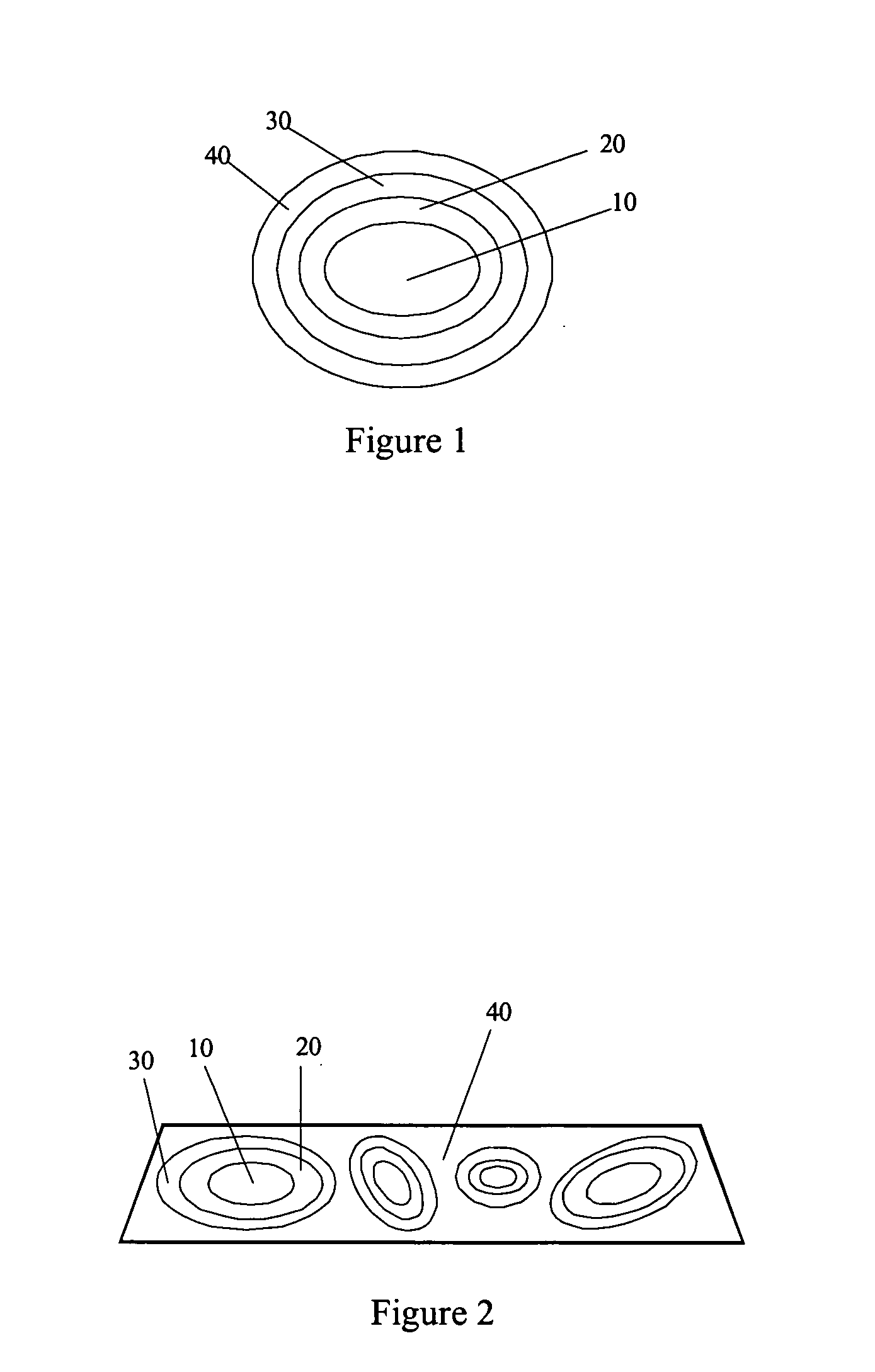Stable chocolate confection containing one or more sugar shelled inclusions
a technology of inclusions and chocolate, applied in confectionery, cocoa, food science, etc., can solve the problems of cracks, cracks, visual and organoleptic defects, fat from the core breaking through cracks into the chocolate matrix, etc., and achieves the effect of simple and effectiv
- Summary
- Abstract
- Description
- Claims
- Application Information
AI Technical Summary
Benefits of technology
Problems solved by technology
Method used
Image
Examples
example 1
[0055] Several lentil-shaped edible core pieces comprising 48% non-fat nut solids, 14% peanut fat, 23% fractionated hydrogenated vegetable fat, 12% sweeteners, and 3% minors such as flavor, salt, and preservatives, were coated with chocolate at a chocolate to inner layer ratio of 0.26:1, to produce several lentil-shaped confections. Next, a sugar shell was applied to the confections to produce hard panned sugar-shelled, lentil-shaped confections. Several of the confections were then covered with chocolate to produce a candy bar. The chocolate bar was then cycled in a cabinet for 8 hours at 31° C. and 16 hours at 20° C., i.e., one full cycle is 24 hours long. This technique was to simulate extended shelf life. A control chocolate bar having lentils comprising 48% non-fat nut solids, 14% peanut fat, 23% fractionated hydrogenated vegetable fat, 12% sweeteners, 3% minors such as flavor, salt, and preservatives, and no chocolate coating were produced and sugar shelled as above. The sugar...
example 2
[0058] Peanut creme centers are prepared using the same composition employed in Comparative Example 1. A chocolate barrier layer is panned onto the centers until the weight ratio of the barrier to center is about 0.3:1. The resulting creme centers having a barrier layer are then sugar shelled and chocolate bars are prepared in the same manner as Comparative Example 1. The chocolate bars made herein and in Comparative Example 1 are then tested as described in Example 1 and the chocolate bars of Comparative Example 1 exhibits fat deposition in significantly fewer cycles than the chocolate bar of Example 2.
example 3
[0059] Chocolate bars were molded with the following inclusions:
Cycles For SlightInclusionsFat DepositionMini Peanut Butter sugar shelled1confection (no barrier)Sugar shelled peanut butter confection2(no barrier)Sugar shelled peanut butter confectionNo evidence at 24(barrier:core = 1.3:1)cycles
[0060] The bars containing the above-identified inclusions were placed in a cycling cabinet and exposed to 8 hours at 31° C. and 16 hours at 20° C. Slight fat deposition was indicated if 1-6 blemishes were observed on the product. This example shows the clear advantage achieved with a barrier. However, it was determined that the 1.3:1 barrier to core weight ratio resulted in masking of the peanut flavor of the inclusion in the chocolate matrix. Thus, the use of the inclusions set forth in Example 1 having about a 0.3:1 barrier to core weight ratio were preferred.
PUM
 Login to View More
Login to View More Abstract
Description
Claims
Application Information
 Login to View More
Login to View More - R&D
- Intellectual Property
- Life Sciences
- Materials
- Tech Scout
- Unparalleled Data Quality
- Higher Quality Content
- 60% Fewer Hallucinations
Browse by: Latest US Patents, China's latest patents, Technical Efficacy Thesaurus, Application Domain, Technology Topic, Popular Technical Reports.
© 2025 PatSnap. All rights reserved.Legal|Privacy policy|Modern Slavery Act Transparency Statement|Sitemap|About US| Contact US: help@patsnap.com

